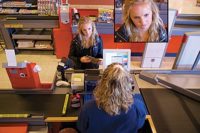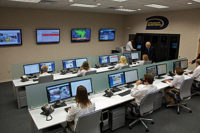|
In this article: |
Today’s analytics offer a two-pronged value and can provide integration with point of sale systems, allowing operators to be able to review video of transactions that just don’t seem right. While effectively fighting shrinkage, they also provide actionable information for marketing and operations departments. Retailers are seeing very good results and ROI as well.
The U.S. Commerce Department reported total retail sales in 2011 were $4.7 trillion, an 8 percent increase over 2010 total retail sales. The retail industry’s sheer size presents a big target for internal and external criminal activity, creating a major issue for retailers — to the tune of $119 billion in shrinkage in 2011, up 6.6 percent since 2010.
Research firm The Aberdeen Group just released a report, “The State of Loss Prevention in Retail: Controlling Losses and Maximizing Profits,” which emphasized the role of analytics as the source of intelligence necessary to protect profitability and combat shrinkage. According to the April 2012 report, “Retailers should begin to define loss as an inability to sustain profit. The only way to pinpoint where these losses reside, and which operations should be redefined, is through analytics.”
The report also states that retailers are learning “they need access to real-time data to stay one step ahead of recurring shrink. By using intelligent solutions to gain insight into loss … they can curb shrink and improve profit.”
Says Al Shipp, chief executive officer, 3VR, San Francisco, “Video is the largest unstructured data that any enterprise has to deal with — in retail or any other vertical. Until today it has been a huge cost shouldered by the security department because you would have to store it and management couldn’t use it. But now we are seeing the shift in getting better information from video and helping industries receive and act on powerful information from video through analytics. Retailers were among the first in to figure out that information coming from the video system could create real business value. In addition to loss prevention, video analytics can help optimize staffing; evaluate promotion and marketing performance; collect real-time shopper data; reduce fraud; and deliver a lower total cost of ownership.”
"Retailers were among the first in to figure out that information coming from the video system could create real business value."~ Al Shipp, chief executive officer, 3VR |
Simon Reed, business development executive, GWIBS 24-7, Bingham, Nottingham, England, says, “Analytics are generating insights that are not possible by any other means. We wanted to provide the client with a new way of thinking about CCTV. The flexibility of our IP CCTV and video analytics platform means we didn’t want them to think of it as a security system, rather a retail support platform that delivers business insights, whether that be customer behavior, operational effectiveness or loss prevention.
“The client learns more about their own people, services and, more importantly, customers in real time with the analytics information. Collaboration with store layout design and operational teams is creating sales floor environments that are more attractive to the customer, yield increased productivity and are more secure. Information and insights on the customer have great potential to generate income from their suppliers and partners,” Reed explains.
Analytics for 2 Fronts
Today’s analytics offer a two-pronged value. While effectively fighting shrinkage, they also provide actionable information for marketing and operations departments as well.
“People will typically think of analytics as far as addressing shrinkage issues, but while that’s important, analytics are being used more and more as a marketing tool as well: to know which areas of the store have more traffic; which locations have an impact on overall sales; where to put displays, special offers, etc. This provides maximum value from the investment. With analytics not only keeping track of theft issues, but also customer needs as well, it’s win-win all around,” says Jacques Albert, pricer and lead architect with Corporation de technologie d’intelligence et d’automatisation international (CTIAI), Montreal, Canada. CTIAI works with Intelligent Security Systems (ISS), Woodbridge, N.J. CTIAI just completed a project involving 730 stores and almost 10,000 cameras with Couche-Tard, the largest convenience store chain in Canada.
Retail analytics’ multi-department value opens an opportunity for security integrators to justify the budget for a security system. “Usually when you start talking about sharing budgets across departments, that resonates really well, so if you know of a point in a video surveillance system that serves security and analytics where the marketing side of the house can utilize reports generated from the camera and the security side can use it to generate alerts during the evening or after hours, then your sales pitch is easier,” says Brian Karas, director of field engineering, VideoIQ, Bedford, Mass.
Analytics have already won favor with online retailers, and today’s video analytics are allowing that same business information to be done for the brick-and-mortar stores as well, Shipp describes.
“The analytics systems are providing information that security, operations and marketing departments can act on, and integrators need to learn to not just call on the security guys, but also the merchandising and marketing departments as well. This is a new space that is being created as we speak,” Shipp says.
It is a new challenge for today’s integrators — getting multiple divisions to work together and share the cost.
“I would say that the main challenge is to bridge the gap existing between the security/loss prevention teams and the marketing/branding teams. Up until today, these were two separate business units with different needs, and old analog CCTV solutions did not enable using the same solutions. With the advance of IP CCTV and the introduction of affordable retail analytics, it became easier to use the same infrastructure to answer the requirements of these two separate divisions,” Reed explains.
In addition to getting the separate departments to successfully interact, integrators may have to convince retailers that the problem applies to them. Reports frequently show that many retailers don’t think they have a problem with employee theft; however statistics show otherwise, listing employee theft as the leading cause of shrinkage for retailers. See “Inside Job” on page 70 for the studies exposing the impact of employee theft.
“In this economy a key goal for retailers in corporate meetings is ‘How do we get more out of the same things we have right now without spending more money or extending ourselves?’ The answer is through loss prevention. Loss prevention is killer to a business. Your profits are walking out the door. According to the Association of Certified Fraud Examiners, of business that fail, 60 percent that fail do so because of internal theft. On average the employee retail theft we’ve caught is $75 to $100 per day and often people are doing it almost every day of their shift,” says Chris Swanger, corporate director of marketing, eConnect Inc., Las Vegas. “An average crime doesn’t start as a scam though. It usually starts with an accident that doesn’t get caught. An employee performs a function on retail side, accidentally realizes they are able to manipulate money and then starts to repeat the action.”
Watch the Point of Sale
Today’s analytics can provide integration with point of sale systems, allowing operators to be able to review video of transactions that just don’t seem right. It helps companies find and manage those “accidents” which generally occur with transactions that fall outside the normal course of business, such as voids, no sales, refunds (the National Retail Federation’s annual Return Fraud Survey estimated return fraud alone cost retailers $14.4 billion in 2011), discounts, managers’ comps, cash drawer opens, etc.
Previously, video systems could monitor people and transactions, but searching for a specific video related to a specific transaction could be a little like finding a needle in a haystack — or be time consuming at best. Most experts agree that even the best auditors can only look at a limited number of incidents per day (typically fewer than 30, based on industry averages) when using video that’s not synchronized with the point of sale (POS) transaction log, which many analytics companies offer linking video clips to every transaction. eConnect uses its POS Connect to provide customers with exception reporting and business intelligence searches based on POS transaction details..
“We dig up all the needles in the haystack so the end user can take a look at them. Within a couple clicks/seconds we give the investigator or business owner a quick and easy way to see the things that are important to them. There’s no hunting around and no random reports, and watching the corresponding video helps immediately recognize when there is something to address,” says eConnect’s president, Henry Valentino.
Swanger adds, “The moment people see the demo, they want to implement the system. On average our system pays for itself within two months according to our customers. Just at one location we had seven arrests in one month because of the system.”
Video analytics have an immediate effect on a retailer’s bottom line. In the second quarter of 2009, San Francisco-based grocer, Draeger’s Markets, implemented the Hawkeye solution from Agilence, Camden, N.J., which pulls data directly from POS and synchronizes it with video. By the end of fiscal year 2009 (December 31), Draeger’s realized a return on investment (ROI) of more than 20 times its initial investment.
“There’s a famous business axiom that says you cannot measure what you do not know — but Agilence enabled us to see the margin-robbing activities that were once unknown to us, and gave us a way to track and measure the effectiveness of the correction,” states Richard Draeger, president and CEO for Draeger’s Markets. “It all boils down to the positive impact to margin.”
Another large retail chain, Matas, also experienced the pain of not having POS integrated with video. “When we had to identify shrinkage and procedural errors and clarify doubts about payments or giving change, we would sit and manually compare the video evidence with point-of-sale (POS) events from the cash register, because the systems were not integrated. It was costly and also meant that we had to make random guesses about possible false transaction events at each cash register,” says Marianne Gernyx Sejbak, security manager at Matas.
Matas decided to implement new advanced video surveillance equipment in 65 of its large stores, which could correlate transactions from cash registers with video monitoring. The video surveillance solution consists of XProtect® Corporate and XProtect® Retail software from Milestone Systems.
“Because the systems are now synchronized, we are automatically alerted by the monitoring system when something seems abnormal at the cash register,” says Helle Bakkendorf, shop controller and daily user of the system. “Cash registers might have been opened without any purchase taking place, or there might be canceled transactions where the customer pays in cash but the money is not in the cash register, suspicious transactions after closing, return sales on an exact amount, and so on. We can target our investigative work much better than before.” To read the full case study, search “Matas” at sdmmag.com.
Real time alerts are another benefit that retail analytics provide.
“The problem traditionally has been that a lot of security is used as an after-the-fact, forensic tool. Retailers, however, more and more are not satisfied with that. Profit margins in the retail world are typically small, and retailers are increasingly demanding more, quick ROI. With Couche-Tard, we were looking at retail stores losing up to $5,000 a week. That number has been drastically reduced due to such alerts, and this more than pays for the cost of the analytics. One of the things that was really crucial to all of this was that we did a lot of testing prior to installation. Custom fitting a solution, particularly of such size, is crucial,” Albert shares.
Video analytics in retail is changing from being used mostly for people counting application into additional areas which provide value to operations, marketing and security, explains Zvika Ashani, chief technical officer, Agent Vi, Rosh Ha’ayin, Israel.
“Agent Vi has introduced several interesting new applications for the retail market. One such solution is the Site Map, which allows using the inputs from all surveillance cameras on the store floor to generate a map showing traffic patterns and hot spots. This data can also be linked directly to the video recording and provide insights into store operations, which are otherwise very difficult to achieve.
"Some analytics are even smart enough to recognize whether you are looking at the ad, and if not, raising the volume or creating some visual effect to grab your attention."~ Derek Rodner, vice president, Prpduct Strategy, Agilence |
“Another such solution is queue management, which allows measuring average queue wait times and providing this information either in real time or offline. The data generated by this application is then used for optimizing store staffing and improving customer experience,” Ashani says.
Analytics also allows retailers to customize in-store advertising via digital signage and analytics.
“One of the more interesting ideas really starts to recall the movie Minority Report. There is a scene where Tom Cruise is running through a hallway and the ads on the walls are reading his iris and serving him personalized advertising. We aren’t quite there yet, but we are close. Retailers are now able to use digital signage with an embedded camera and analytics. As you pass the digital sign, the analytic in the camera can quickly make basic demographic determinations. Are you a male or female? Are you under 18? Or over 55? It then relays the basic information to the digital sign advertising database that returns an ad that appeals to your demographic. This means men over 18 might get ads for razors, while older women might see an advertisement for arthritis medication. Some analytics are even smart enough to recognize whether you are looking at the ad, and if not, raising the volume or creating some visual effect to grab your attention,” says Derek Rodner, vice president, Product Strategy, Agilence.
The possibilities just keep growing.
“Most customers don’t realize the extra potential that analytics have that can benefit their organization, that can even go beyond security. The integrator has to make the argument. Although analytics has been discussed for almost 10 years now, and on the one hand people want a lot from analytics, there is still an underestimation of where analytics can be deployed,” says Illy Gruber, product manager, NICE Systems, Ra’anana, Israel.
For any technology to have mass appeal, it must reach a level of “off-the-shelf” simplicity, Rodner shares.
“There are a few technologies that have reached this point today. One is people counting. Video is no longer just a tool for security and loss prevention. Store managers can use people counting analytics to help plan their workforce schedule. Marketing departments also use dwell time analytics to measure how long a customer lingers near a sale rack and compares that information to help figure out if a change is needed to the promotion. Did they see the sale sign? Did they stop and linger? Did they purchase? Out-of-the-box analytics can perform people counting and dwell time analysis with little configuration and still be quite accurate.”
Technical Considerations for Integrators
Still, Keith Marett, vice president of marketing and communications, Avigilon, Vancouver, British Columbia, Canada, cautions, “While the application of the analytics is off-the-shelf in how the analytics are applied, because each retail setting includes its own sight lines in terms of shelving, its own unique lighting, and so forth, each one needs to be customized at the individual location.”
A more accurate explanation is that there are “levels” of off-the-shelf, explains John Romanowich, president and chief executive officer, SightLogix Inc., Princeton, N.J.
“Today’s products are becoming more inherently plug-and-play. For example, when integrators first set up a SightLogix camera, they simply enter the height of the camera off the ground and the camera automatically calibrates itself to determine the actual size of every object in the field of view using GPS technology. However, while basic plug-and-play video analytic capabilities have arrived, with a few steps of additional configuration advanced benefits can be achieved. We have an enterprise-class capability that allows for mapping the GPS coordinates of detected targets onto a site map for situational awareness, and auto-steering PTZs to follow targets. Enterprise mode does take a few additional minutes of configuration time per camera, but provides comprehensive situational awareness, desired in applications where there are more than a few cameras,” Romanowich explains.
For all the analytics possibilities, integrators can consider starting off with just one type of analytic in order to ensure success, advises Scott Schafer, executive vice president, Arecont Vision, Glendale, Calif.
“A number of integrators are still trying to pull together their abilities to go sell that feature set. I would advise to start small. Don’t get too wild with the first implementations. Prove your company can do one type of analytics like people counting or POS integration first and then go from there. Make sure you are able to support that one analytic or series of analytics by testing yourselves first. Then, when you deploy, work hand in glove with the retailers as it gets set up to help them get the best results possible the meet their needs,” Schafer says.
In the process of choosing the analytics to offer, most will advise taking extra time to choose the right vendor that fits your goals. For example, if you are focused on performance and detection rates, find a vendor focused on that as well.
“Success is all about selecting the right vendor that shares your focus. Just going to get the license from the vendor, doing three or four days of training and deploying the system yourself will not guarantee optimal results. Success is not just about finding the vendor with the cool technology, but one who is willing to work with you hand-in-hand to provide the professional services and together be able to predict and guarantee a specific performance,” NICE’s Gruber advises.
NICE says it is very hands on with its integrators. The company will advise where to put the cameras, will help write the site survey, do initial tests, and even go back after two weeks and advise how to tune and tweak the system.
Marett also emphasizes turning to manufacturers for advice — because they see a lot.
“If your expertise is around security analytics and end users ask about business analytics, then a lot of time manufacturers will have experience in that area and can help,” Marett says. “Think about what you are hoping to accomplish based on the end users’ needs and then really work closely with manufacturers to see what is out there and what they have already done in the past. We work with integrators around the world, so we’ve usually already come across the program, and there is no need for integrators to ‘reinvent the wheel’ or solve the problem all over again,” Marett encourages.
New algorithms, new processing in the computer platform, enhanced analytics capabilities improving along with high definition (HD) cameras all enable retailers to know more and see more, right down to the denominations of the bills being taken out of the register, says Reinier Tuinzing, strategic alliances manager, Milestone Systems Inc., Beaverton, Ore.
“As all these things come together, the usage of the analytics is changing. We’re moving from a technology looking for an application to a situation where customers are starting to understand better what to do with the technology as they get more educated on the capabilities. Algorithms are improving and getting better and they are taking into account real world environments like retail, allowing industries to capitalize on the technology,” Tuinzing says.
Accounting for the “real world environment” during setup can increase the performance of the system, says Dave Jackson, senior product manager, American Dynamics, part of Tyco Security Products.
American Dynamics’ victor, a unified video management system, has the ability to turn on the analytics and let them run for a week and then do searches on that real world data just recorded and use it to calibrate the system.
“You literally push a button and victor creates the rule on the other side for real-time alerts. Use real world data and later you will be able to identify the behavior you are looking for without getting false positive results,” Jackson shares.
Jackson also recommends careful installation while navigating retailers’ low-budget mentality. “Many retail stores have large numbers of cameras in terms of their density, but the retailers want to pick and choose what cameras have the analytics on them, picking the most ‘bang’ for their investment. One key is making sure that as the cameras are installed that you have enough coverage, but not too much coverage for cost reasons. The other challenge is that stores tend to be high traffic areas. You must have the proper field of view as you install the cameras and create settings you are able to adjust for rush periods or during sales.”
Karas advises installing with a different mindset than general surveillance. “A lot of times with general surveillance when you are mounting a camera you are paying the most attention to aesthetics or what is the most convenient mounting point, but with analytics you are putting more thought into where the camera can be best positioned to get a clear view of the scene. Many times in retail environments it will be counter to what you initially might think. For example, the best location for accurately counting people is overhead mounting. But that prevents you from getting facial details, so a lot of times the cameras for analytics are installed in addition to the security cameras,” Karas says.
Treat every installation uniquely, Jackson advises.
“Tuning an analytic solution and making it work takes awareness and understanding that every camera install is unique. A clothing retailer versus a bank will be completely different. Even within the same store, the light situations, display racks and traffic patterns will be different from one side of the store to another. Those integrators that are recognizing the value of analytics and also have invested in the training for their personnel to navigate the nuances of proper installations are seeing very good results and ROI,” Jackson says.
Retailers are seeing very good results and ROI as well. That’s a win-win.













